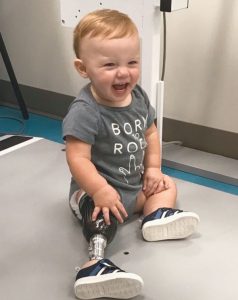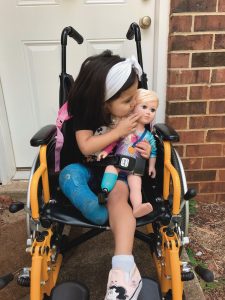As every parent learns, raising kids is a series of decisions from mundane to momentous: Oatmeal or Frosted Flakes? Soccer or piano? College or trade school? For parents of a child with medical conditions, there are more decisions, and they’re more intense. Just ask the parents of a child who has a condition with a limb difference that may require amputation. In this story, you’ll meet three of those children: Maely, Braxton, and Jamie. As Braxton’s mom, Bree, says, “This decision was the hardest decision I have made or will ever have to make. I am making a decision that will forever change someone else’s life.”
Becoming informed and educated
Bree, Josh and their daughter, Hartley, were ecstatic to welcome two new bundles of joy into their lives – twin boys Braxton and Jackson.

Braxton smiles big during a doctor’s visit.
But Braxton was born with a difference that could not be ignored – part of the bone in his thigh was missing. Braxton had right proximal femoral focal deficiency, or PFFD, a complex birth anomaly in which the upper part of the femur (thigh bone) is either malformed or missing. Treatment options range from limb-lengthening to amputation at different lengths, prosthetics and a host of different surgical procedures. There is no “one size fits all” approach, making it difficult for parents to know what is right for their child. “This is why I was not going to stop until I had all the information I needed, and most importantly found a doctor I felt most comfortable with overseeing his care,” Bree said.
While gathering recommendations from many medical professionals, Braxton’s parents met Janet Walker, M.D., at Shriners Hospitals for Children Medical Center — Lexington in Kentucky.
“Dr. Walker picked Braxton up and held him at our first appointment. He seemed so calm with her. Our local doctor never even held him,” Bree said. “And Dr. Walker was so knowledgeable about Braxton’s condition and the future journey we, as a family, would be facing.”
This and future appointments helped Bree and Josh become comfortable with a treatment plan to amputate part of Braxton’s leg. “As a mom, knowing this is a condition he will deal with his entire life, I wanted to set Braxton up for success from the beginning, and this is exactly what the team at the Lexington Shriners Medical Center is giving him,” she said.

Jamie with her doll, who also has a prosthetic leg.
Another of Dr. Walker’s patients, a young girl named Jamie, also saw many doctors before having her amputation. Jamie was born without a fibula, one of the bones in the lower leg, a condition called fibular hemimelia.
“Do all you can to educate yourself until you feel a peace of mind in your decision,” Jamie’s mother, Melissa, recommended. “Do not let anyone judge the decision you end up making, because no one knows your child better than you.”
Jamie, now 4, is an active little girl who loves to run and play and dreams of growing up to be a doctor. “Everything we had done to get to this point was worth every cry and heartache,” Melissa said.
Finding the positive
Megan and Matthew were at the doctor’s office for an ultrasound. Megan was 20 weeks pregnant with their first child. They weren’t going to ask the sex, Megan said, because they wanted to be surprised. The test was to monitor the health of the fetus. As the ultrasound progressed, it became clear something was wrong.
Doctors told the couple their baby’s leg was missing its fibula, one of the two lower leg bones, and her foot looked different. They wouldn’t know more until the baby’s birth.
“It was the worst day of my life,” Megan recalled. She said she and Matthew went home and did what everyone is told not to do, yet most do: They went online. What they found frightened Megan Most upsetting was the idea of amputation. It felt like a worst-case scenario to her. “I wouldn’t even look at the word,” Megan said, “because I didn’t want to think about it.”
In a social media group, Megan connected with other mothers in the Chicago area. One invited Megan to her home to meet her son, a 2-year-old boy who had an amputation and used a prosthesis.
“Seeing him, I was so encouraged,” Megan said, tearing up at the memory. “There was nothing different about him. There was nothing wrong.”
Meeting little Jonathan helped Megan reset her hopes for her baby. “He gave me peace,” Megan said. Although amputation is not the best or only choice for everyone with a similar diagnosis, Megan said that when Maely was born, it was clear that amputation would be right for her. Still, it wasn’t easy. “It’s the idea of the unknown, putting your baby through a surgery,” Megan said.
Maely’s parents thought about little Jonathan and made a decision. “We chose to have a positive attitude about it,” Megan said. “That was a decision.”

Maely has used a custom prosthetic leg since she underwent amputation surgery as a toddler.
Jeffrey Ackman, M.D., pediatric orthopaedic surgeon at Shriners Hospitals for Children — Chicago performed Maely’s amputation surgery. She also received her first few prosthetics from the Chicago Shriners Hospital. (After a recent move, the family is now seeing the team at our Salt Lake City location.) Now, Maely is 4, goes to preschool and is an engaging little girl. She loves eating avocados, singing and playing guitar with her dad.
“I wouldn’t change her if I could,” Megan said. “It makes her who she is. It’s given us a chance to talk to people we never would have before, and it leads us to new friendships.”
TO LEARN MORE about the orthropaedic and orthotics and prosthetics programs at Shriners Hospitals for Children, please visit shrinershospitalsforchildren.org.





